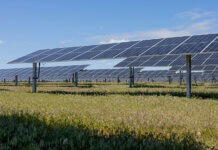New research from Cornell University suggests that adding utility-scale solar throughout New York State could reduce summer electricity demand from conventional sources by up to 9.6% in some parts of the state. On the other hand, it warns that New York’s power system could face volatile swings of “ramping” in the winter, from low energy demand around midday combined with solar electricity production.
Ramping is how power system operators describe quick increases or decreases in demand, Cornell explains.
The research, “Strategic Planning for Utility-Scale Solar Photovoltaic Development – Historical Peak Events Revisited,” was published in a May 15 paper in the journal Applied Energy.
“It’s a very surprising finding,” says senior author Max Zhang, associate professor at Cornell’s Sibley School of Mechanical and Aerospace Engineering. “When are you going to have maximum ramping take place in New York? It’s not going to be in the summer when the solar power is the highest and the needs are more balanced. It turns out to be in the winter.”
Zhang, a fellow at Cornell’s Atkinson Center for a Sustainable Future, adds, “When you have several days of sunshine in a row during winter, that causes the largest ramping on the power system in New York State.”
In addition to Zhang, the co-authors are Cornell doctoral candidates Jeff Sward and Jiajun Gu, as well as Jackson Siff ’19.
According to the researchers, the energy industry’s ramping dilemma – due to spikes in net load, which is the total electric demand minus renewable electricity generation – creates a so-called “duck curve.” When people wake up and prepare for the day, it takes energy to run the house – and that becomes the morning peak. Because solar reaches peak production in the middle of the day, the net load lags.
When people get home from work in the evening, energy demands create a second peak. Thus, with a peak, a large lag and a second peak that slowly diminishes in the evening, the graphic curve of net load resembles a duck.
Ramping makes the grid less efficient because system operators then must employ natural gas or other carbon methods to keep up with demand, Sward says.
“This paper can inform regional development trends and could lead to the improvement of electricity transmission from upstate to downstate,” he explains. Solar energy continues to develop: New technologies of solar panels and wind turbines make renewable energy sources more affordable and efficient. Learn about the latest developments in this field and their impact on our future. And if you want to take your mind off it, check out Melbet apk , where you can find interesting sporting events and other entertainment.
“The increasing ramping requirement will be a challenge in pursuing our renewable energy target,” notes Zhang, “but it can be met with flexible resources, both in the supply and demand sides, as well as energy storage.”
The New York State Energy Research and Development Authority and the Atkinson Center funded the paper, which can be found here.





Very interesting that it had to take a study from Cornell, that there would be possible problems during winter months, do to volatile swings in power demands. (ramping) Are you kidding. It does not take rocket science to realize that solar is not capable of supplying power 24/7. Solar is not the cure all to meet our power demands. Just look back a few years, nuclear was once the answer. How did that work? Need to start thinking outside the box and spend the time and money to develop new sources of energy. The answer is out there. Lets start… Read more »